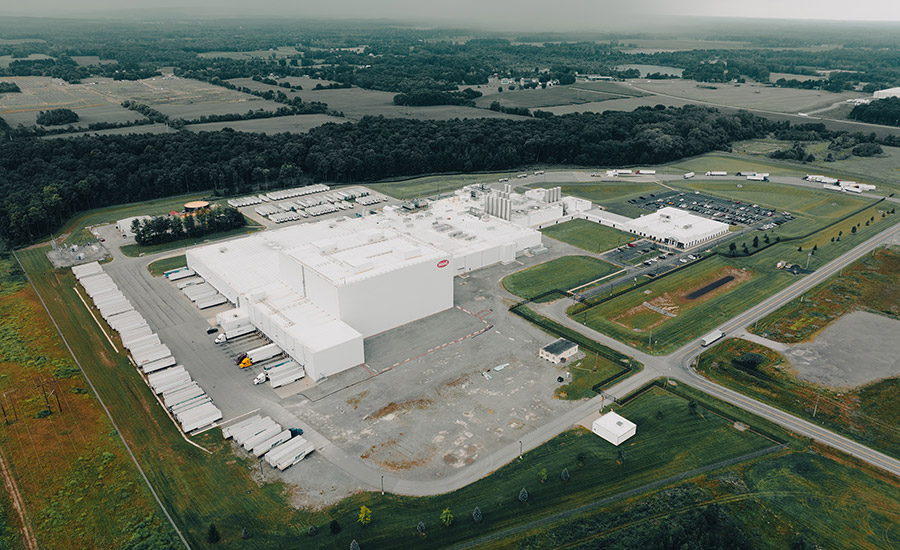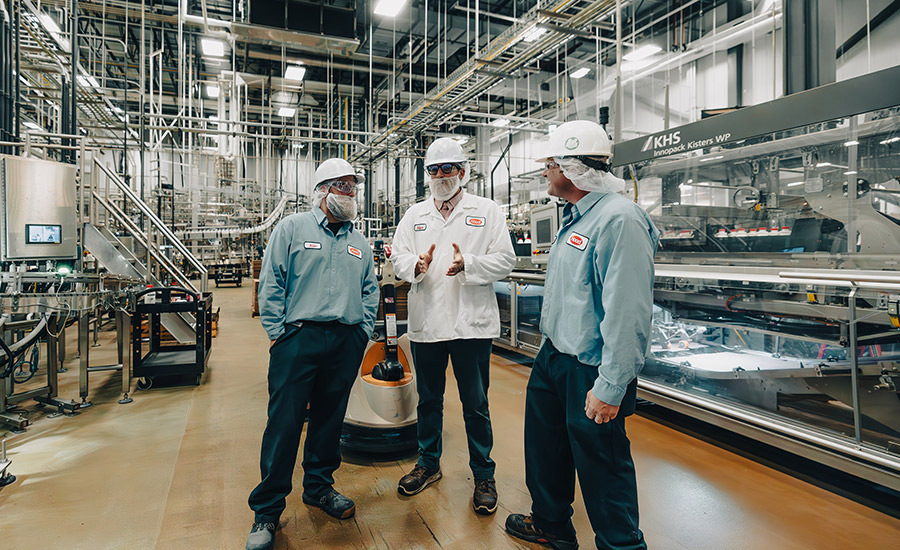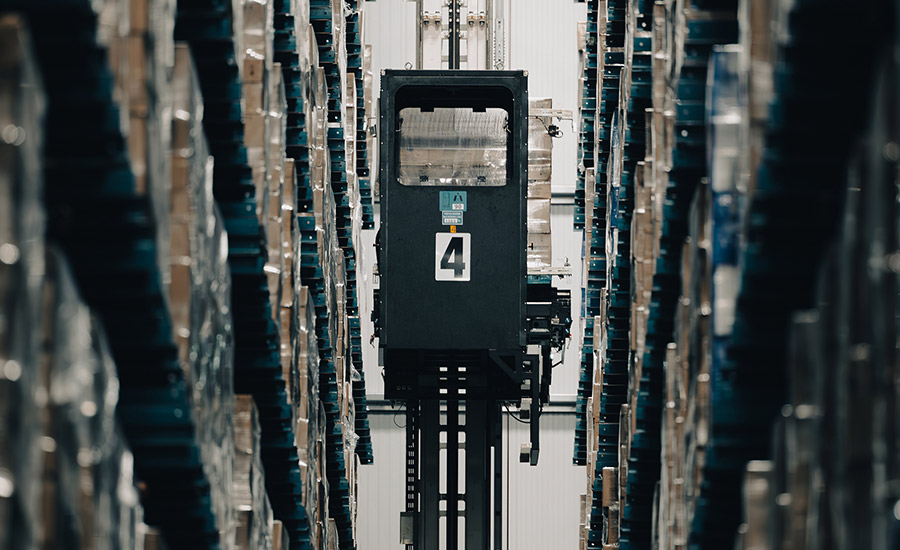
There are a lot of things HP Hood LLC’s Batavia, N.Y., plant could be honored for this year, including the many bells and whistles featured at the 458,000-square-foot plant. Its involvement in the Batavia community, its impressive automation and processing equipment, and the wide array of products it produces there, including dairy and non-dairy products, are definitely big reasons it was named Dairy Foods’ 2024 Plant of the Year.
But the plant, located between the cities of Buffalo and Rochester, N.Y., goes way beyond that. Hood’s commitment to employee safety is unquestioned, a key reason it earns our Plant of the Year distinction. As Dairy Foods toured the facility in late July, it is difficult not to be impressed with this commitment to safety. Safety signage was prevalent throughout the facility, including a safety communication bulletin board offering advice and tips, which is updated as often as twice a week.
We also stepped in to briefly watch employee training sessions that take place at the site, which sits on 133.4 acres of land in western New York.
“The safety culture at the plant is supported by two pillars: One is a response to lagging safety data, and one is a proactive embrace of leading safety performance, both of which are owned and anchored by the plant’s front-line supervisors,” the company noted in its Plant of the Year application.
“In 2023, an Incident Reporting & Investigation roadmap was formally developed and applied to all incidents, beginning with prompt and concise incident reporting, continuing through one-on-one employee engagement and root cause analysis, and culminating in an After-Action Review and corrective/preventive action closure, with the ultimate goal of preventing reoccurrence per incident.” This practice has been effective at driving hazard recognition and elimination within the plant, HP Hood reports.
“Continuous improvement is part of Hood’s mission statement. Striving to improve employee safety is central to that mission and is reflected with the results that we see at this plant. That is what makes a plant better. Everyone is involved, including line leaders and those working on the lines,” relays Scott Blake, senior vice president of operations at HP Hood.
Achieving Results
The Batavia plant, which employs 418 people, has already won the Genesee County Economic Development Partner of the Year Award in February 2020, and the Buffalo Business First Manufacturing Award for Operational Excellence in May 2023.
Of course, the bells and whistles of the plant should be noted. Some things are easier seen and difficult to explain, but the results of technological improvements and strategy of operational excellence are easier to quantify.
The plant installed state-of-the-art technology to support growth, such as additional set tanks, an automated layer and case pick system, full pallet labelers, and key infrastructure upgrades, such as chiller and air management.
The automated layer and case pick system, commissioned in early 2024, is designed to pre-pick product for specific customer orders ahead of the scheduled pickup, so that it is ready to go upon carrier arrival. This system includes nine automated AS/RS cranes, 24,192 pallet positions, and 13 loading docks.

The Hood facility, named the 2024 Dairy Foods Plant of the Year, is located in Batavia, N.Y., between the two larger cities of Buffalo and Rochester, and spans 458,000 square feet on 133 acres of land.
According to Hood, results of this system include carrier dwell time dropping by more than 50%, on-time delivery performance greater than 99%, and significant ergonomic improvement increasing employee safety, all culminating in an increase in overall customer satisfaction.
Plant History
In 2012, the Batavia plant was built by Muller Quaker Dairy LLC, which was a joint venture between PepsiCo Inc. and German-based Theo Muller Group. In 2013, the plant opened as a yogurt processing and packaging plant.
By 2015, after the partners determined the business was not meeting expectations, Muller Quaker Dairy LLC hung a for-sale sign, and the plant was purchased by Dairy Farmers of America (DFA). In June 2017, Hood bought the plant from DFA with the intention to process, package, and ship extended shelf life (ESL) dairy and non-dairy fluid products. By the fall of 2017, Hood sold all its yogurt processing equipment. Hood then finished design and began renovation and retrofitting the new facility.
“We saw it as a first-class facility that would complement Hood’s existing ESL national footprint,” Gary Kaneb, Hood president and CEO, tells Dairy Foods. “When the plant was initially put up for sale by Muller Quaker Dairy LLC in 2015, we thought we would incorporate it into our cultured manufacturing network which consisted of three New York plants.”
However, by 2017, Hood’s ESL capabilities were being stretched, Kaneb notes. “We had evaluated various sites, but nothing worked in the timeframe we needed. So, it made sense for us to re-outfit the yogurt plant [in Batavia] for ESL since it already had the infrastructure in place for dairy operations.”
The first three lines installed at the plant produced half-gallon almond milk products operated by only a handful of people. Lactaid Dairy Products followed shortly after.
In addition, Hood commissioned an automated, high-bay, high-speed, 82,000-square-foot refrigerated warehouse. In the summer of 2018, Hood shipped its first products produced in the facility.
Today, the Batavia facility fulfills branded, private label, and contract orders, processing 96-ounce and half-gallon ESL almond and dairy drinks, 32-ounce non-dairy creamers, and 40- to 48-ounce ESL cold coffee drinks.
In 2022, the plant produced 118 million gallons, with a 150-million-gallon capacity. In the future, it has the capacity to expand processing to 179 million gallons, with nearly half budgeted for 96-ounce containers.
“Our engineers, led by Lee Baker, a 30-year employee and talented engineer, was a key player in the original design of the facility,” Kaneb says.

Hood does many things to make sure employee culture is excellent, including employee roundtables, various seasonal events, health/biometric screenings on-site, chili cook-offs and bake-offs, plus much more.
“We started out with a couple of lines and laid it out for anticipated growth. We thought it would take much longer than it has to get to where we are today,” Blake adds. “The growth we have had here is phenomenal.”
Blake continues the company makes its own plastic bottles — which we witnessed — at the Batavia plant, which provides an advantage. “It helps to make our lines much more efficient when we can control the quality of the bottles as well as eliminating handling bottles coming from the outside.”
National footprint
HP Hood operates 12 plants, four of which are aseptic/ESL facilities in Batavia; Oneida, N.Y.; Winchester, Va.; and Sacramento, Calif. These four plants provide dairy products to all 50 states. Hood also has eight other plants. Three plants produce cultured dairy, one processes ice cream, and four manufacture fluid milk products.
“A relatively small percentage of the products we produce are sold under the Hood brand,” Kaneb notes. “Our brands of lactose-reduced milk, almond milk, and oat milk are the No. 1 brands in their respective categories, nationally. We are also a national manufacturer of private-label aseptic/ESL products for several major retailers.”
A key component of the Batavia plant’s success was the addition of Mike Corporon, vice president of ESL/aseptic operations, as well as Dave Watkins, director of Batavia operations, Blake asserts. “We brought in Mike when we first started the facility here. He has been instrumental in our success,” he says. “And Dave came from another plant. He has been with us for 32 years, spending a lot of time in the cultured division. He wanted to transition to the ESL side. He came in as our production manager and has done a fantastic job.

The Hood plant is at the forefront of innovation and automation, including installing additional set tanks, an automated layer and case pick system, full pallet labelers, and key infrastructure upgrades, such as chiller and air management.
“We have a philosophy to be very collaborative. We talk to all of our team members before making big decisions,” Blake adds. “That has proven to be very successful.”
Hood was a pioneer at its Oneida facility with ESL and Kaneb is optimistic about its continued growth. He explains: “When the Kaneb family acquired Hood in 1995, sales were about $500 million. Since then, Hood has added additional plants, Winchester (2000), Sacramento (2007), and Batavia (2017). With the addition of this capacity, Hood’s sales have grown to approximately $3.5 billion today. The growth in all of our national brands and private label has been impressive.”
Company History
Hood was founded in 1846 by Harvey Perley Hood. In 1900, the first Hood ice cream was sold at a Hood dairy bar on Beacon Street in Boston.
In 1947, the Hoodsie Cup ice cream cup was introduced, in 1972 Hood became the first dairy company to produce frozen yogurt in the United States, and in 1975, it introduced ultra-pasteurized cream.
In 1981, the Hood Family sold the business to Agway and Agri-Mark.
Fast forward to 1995: the Kaneb Family purchased the business from Agway. Since purchasing Hood, Gary Kaneb served as the chief financial officer and later president. Upon his father John’s passing in 2021, Gary took on the additional role as Hood’s CEO.
Blake, a long-time employee, stresses that the Kaneb Family has done a fantastic job of improving the business in its 29 years of ownership. “We were a much smaller company before they bought it. They have continually reinvested in the company to make it what it is today.”
Sustainability efforts
Although Hood does not have an official sustainability statement regarding when it will achieve specific goals, the company has put several measures in place to make sustainability a central focus. “In operations, waste, water, and energy reduction are key areas of focus for the plants,” Blake states, adding “the company views sustainability as a key initiative.”
He emphasized, “We continue to look at ways to improve sustainability in packaging via the cases and the corrugates we use. We also look to increase recyclability in all of our products.”
Corporon stresses since the Batavia facility is new, much of its equipment is more environmentally friendly than what might have been seen in the past. “We have state-of-the-art equipment. Efficient energy use and waste reduction are incorporated as part of the OEM (original equipment manufacturer) design” he states. “We also partner with local energy suppliers to do energy audits and upgrade some of our infrastructure.”
Kaneb adds Hood’s sustainability efforts extend beyond Batavia. For example, a co-generation turbine powers the Winchester plant, and Hood partners with a solar array development at its Agawam, Mass., facility.
“Most recently, we entered into a 12-year commitment to purchase 90 GWh of wind energy annually as part of a wind turbine project just outside of Dallas It is one of the largest wind turbine projects in the country,” Kaneb notes. “Our energy generation as part of this project represents 30-40% of Hood’s annual electricity usage. We are one of six off-takers and our commitment enabled the development and completion of this project, which displaced carbon-generated energy into the Texas grid.

In June 2017, Hood bought the plant from DFA with the intention to process, package, and ship extended shelf life (ESL) dairy and non-dairy fluid products.
“We cannot build solar panels in the Buffalo area for obvious reasons, so a virtual purchase power agreement (VPPA) was a great way to replace carbon-generated fuel,” the CEO adds.
Community involvement
Last, but certainly not least, is Hood’s community involvement. The company is a large employer in Batavia — and the surrounding environs of Genesee County — and takes that mantle seriously. When we visited Batavia, the Genesee County Fair was taking place down the street, something for which Hood takes pride in its involvement.
In addition, the Batavia plant is involved in many other community initiatives, including an annual hospice flower sale, participation in several organizations, including the United Way Day of Caring, Holland Land Museum Historical Winter Wonderland, Sunn King recycling, Muckdogs baseball team, Community Action, Salvation Army’s Holiday Angel Drive, and the Kiwanis’ Books for Babies.
Regarding employees themselves, Hood offers employee roundtables, various seasonal events, health/biometric screenings on-site, chili cook-offs and bake-offs, plus much more.
Approximately 30% of the company’s 418 employees live in the immediate Batavia area and 60% are in Genesee County, Corporon notes. “Some of them worked at this plant when it was owned by Muller Quaker. We have a great presence in this community and employees who are very passionate about local activities. A lot of people have learned that we are a great employer through word-of-mouth.”
Kaneb concludes, “The Batavia plant and its employees is a great story. It has been a key factor in the continued success of the Hood organization.”







